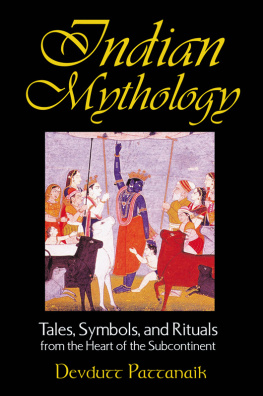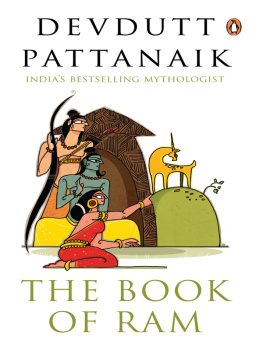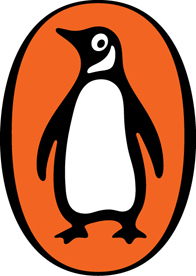Devdutt Pattanaik writes, illustrates and lectures on the relevance of mythology in modern times. He has, since 1996, written over 30 books and 600 columns on how stories, symbols and rituals construct the subjective truth (myths) of ancient and modern cultures around the world. His books with Penguin Random House India include The Book of Ram, Jaya: An Illustrated Retelling of the Mahabharata, Sita: An Illustrated Retelling of the Ramayana, The Girl Who Chose and the Devlok with Devdutt Pattanaik series, among others. He consults with corporations on leadership and governance, and TV channels on mythological serials. His TV shows include Business Sutra on CNBC-TV18 and Devlok on Epic TV. To know more, visit www.devdutt.com.
1
Dhyan and Darshan
In this new season, what should we start with?
Well talk about the Vedas and the Puranas, of course, stories from the Ramayana and the Mahabharata, but before that, lets talk about the poem that I begin all my projects with.
When I started writing books twenty years ago, all my books would open with the lines:
Within infinite myths lies the eternal truth.
Who sees it all?
Varuna has but a thousand eyes,
Indra has a hundred,
And I, only two...
I used to say the eternal truth, where the is the definitive article. Now I say an eternal truth. The concept that Varuna has a thousand eyes is found in the Vedas, and the idea that Indra has a hundred eyes comes from the Puranas. Earlier, I would say And I; gradually, I began to write You and I.
As my knowledge increased, my point of view, or darshan, which is different for different people, changed. And as we meditate (dhyan) on things, our knowledge increases. In twenty years, as my darshan and dhyan changed significantly, so did the poem.
This is a good point to start the new season with: dhyan and darshan. What is darshan?
Ordinarily, people would say darshan is to see. When we go to a temple, we take darshan of god. In films, you will hear dialogues like, Bhagwan, darshan do [Lord, let me see you]. So, darshan is given and takenboth to do with seeing. In Sanskrit, darshan means philosophy or world view.
Dhyan means to pay attention, concentrate, focus.
There is a reason why I use the words dhyan and darshan separately. In Indias history, the Vedas came 4000 years ago, and the Puranas, 2000 years ago. The Vedas contain poetry associated with yagna while in the Puranas stories became very important. The idea of dhyan lies somewhere in between these two. In yagna parampara, or tradition, people followed the rituals, did karmakaand, but they began to ask what these meant. That is, people started thinking about it; they started concentratingthis is known as dhyan.
But it was Buddha who made dhyan really important. He belonged to the Shraman parampara, people who were vairagis (ascetics), philosophersthey were not worldly, and lived in the forest, caves, or viharas (monasteries). Buddha said that performing the rituals and penance (tap)in the form of fasting, physical hardshipalone would not bring knowledge. They would have to mull over, meditate about it. He gave a lot of importance to dhyansit in one place, close your eyes, stay still and do dhyan.
Dhyan has several meanings. One is to contemplate or to think. Another is to not think but to meditate, wherein you stay still and automatically youll get kaivalya gyan, or wisdom. The more you think, the farther youll go from wisdom. There are two schools of dhyanmindful (contemplation) and mindless (meditation).
Closing the eyes is associated with dhyan. Its opposite is darshanopening the eyes.
Post the Shraman tradition, in the Puranic period, when we start telling stories, when temples are established, the word darshan becomes popular. The Vedas give greater importance to shruti, to hear, while the Puranas emphasize seeing. If you observe the idols in temples, they have large eyesLord Jagannath has big, round eyes, Shrinathji has boat-like eyes. In poetry tooVaruna has a thousand eyes, Indra one hundred, and so on. We see god, god sees us. God is presenting himself to us.
Another theory is that dhyan was perhaps associated with sanyasis who were removed from the world and its relationships, whereas darshan was about relationships. About seeing the person opposite youyour brother, sister, wife. With the Ramayana and the Mahabharata, family stories emerge, of the parents, brothers, wives of the protagonists. Society and relationships are important here.
Dhyan and darshan are two opposite concepts. One is external, the other, internal.
Dhyan is about vairagi life, and is Buddhist, while darshan is about worldly life, and is Hindu. This is the basis of Sanatan Dharma.
You keep using the word mythology, which upsets some people. Why do you use this word?
This is not a new word, its hundreds of years old. But the British gave it a negative meaning. I say its a colonial meaning where myth is equated with lies. In the twenty-first century, its meaning is different. We should abandon the colonial meaning and adopt the contemporary meaningneeji satya, vyaktigat satya, mera sach, tumhara sach, meaning ones personal truth. That is myth. When I say mythology, I want people to absorb the new meaning of the word. In English, fact means everyones truth; fiction is imaginary stories (sabka jhoot). Where would you place the Ramayana and the Mahabharata? A scientist would not be sure about its reality, and say theres no evidence. But if you say its fiction, a believer is likely to get annoyed, How can you call our god fiction? In between fact and fiction lies vishwas (faith), which is somebodys truth. When you form a relationship with someone, you have to respect their truth. In earlier times, when there was sanatan satya, they never said something is right or wrong. The Brahmand is eternal, while we have limited lifespans, barely 100 years. The world is anadi, anant, without beginning or end, and we can never know everything.
We all have different kinds of knowledge, but we must keep gathering more and expand our mind (mann). Take darshan of all these truths and think (dhyan) about it so that your mind expands. Mann is manas and in Sanskrit, to expand is brah. So Brahman is to expand your mind. Thats the original meaning of the word.























